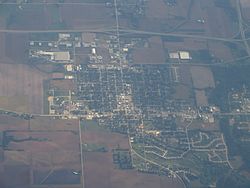DeWitt, Iowa facts for kids
Quick facts for kids
DeWitt, Iowa
|
|
|---|---|

Aerial view of DeWitt
|
|

Location of DeWitt, Iowa
|
|
| Country | |
| State | |
| County | Clinton |
| Area | |
| • Total | 6.23 sq mi (16.12 km2) |
| • Land | 6.22 sq mi (16.11 km2) |
| • Water | 0.00 sq mi (0.01 km2) |
| Elevation | 709 ft (216 m) |
| Population
(2020)
|
|
| • Total | 5,514 |
| • Density | 886.21/sq mi (342.17/km2) |
| Time zone | UTC-6 (Central (CST)) |
| • Summer (DST) | UTC-5 (CDT) |
| ZIP code |
52742
|
| Area code(s) | 563 |
| FIPS code | 19-21180 |
| GNIS feature ID | 0455826 |
DeWitt is a city in Clinton County, Iowa, United States. It is a growing community, with its population increasing to 5,514 people by the 2020 census. This makes DeWitt the fastest-growing city in Clinton County.
Contents
History of DeWitt
DeWitt was planned out in 1836. The city was first called Vandenburg. Later, it was named after DeWitt Clinton (1769–1828). He was an important American politician. DeWitt Clinton served as a United States Senator. He was also the seventh Governor of New York.
A famous writer, Ralph Waldo Emerson, gave a lecture in DeWitt in January 1866. This was part of the Lyceum movement. This movement brought speakers to towns to share knowledge.
Geography of DeWitt
DeWitt is located at 41°49′22″N 90°32′34″W / 41.82278°N 90.54278°W. This is in the eastern part of Iowa.
The United States Census Bureau says the city covers about 5.98 square miles (15.49 square kilometers). All of this area is land.
DeWitt's Population and People
| Historical population | |||
|---|---|---|---|
| Census | Pop. | %± | |
| 1870 | 1,749 | — | |
| 1880 | 1,608 | −8.1% | |
| 1890 | 1,359 | −15.5% | |
| 1900 | 1,383 | 1.8% | |
| 1910 | 1,654 | 19.6% | |
| 1920 | 1,849 | 11.8% | |
| 1930 | 2,041 | 10.4% | |
| 1940 | 2,205 | 8.0% | |
| 1950 | 2,644 | 19.9% | |
| 1960 | 3,224 | 21.9% | |
| 1970 | 3,647 | 13.1% | |
| 1980 | 4,512 | 23.7% | |
| 1990 | 4,514 | 0.0% | |
| 2000 | 5,049 | 11.9% | |
| 2010 | 5,322 | 5.4% | |
| 2020 | 5,514 | 3.6% | |
| U.S. Decennial Census | |||
A census is an official count of a population. It helps us understand how many people live in a place.
2020 Census Information
In 2020, there were 5,514 people living in DeWitt. They lived in 2,266 households. A household is a group of people living together. The city had about 886 people per square mile.
Most people in DeWitt were White (92.8%). There were also Black or African American (1.8%), Native American (0.1%), and Asian (0.3%) residents. About 3.2% of the population was Hispanic or Latino.
The average age in DeWitt was 39.6 years old. About 27.5% of the people were under 20 years old. This means many young people live in DeWitt.
2010 Census Information
In 2010, DeWitt had 5,322 people. There were 2,208 households. The population density was about 890 people per square mile.
The racial makeup was similar to 2020. Most residents were White (97.1%). About 1.9% of the population was Hispanic or Latino.
The average age was 39.7 years. About 25.3% of residents were under 18. This shows a good mix of ages in the city.
Railroads in DeWitt
DeWitt is served by the Union Pacific railway. These tracks are on the south side of the city. They were first built by the Chicago and Northwestern railroad.
In the past, another railroad, the Milwaukee Road, also came through DeWitt. It ran along 7th Avenue. This railway stopped operating in the area by 1970. You can still see signs of old rail uses on 7th Avenue. Some buildings used to load and unload goods from trains.
Major Highways in DeWitt
DeWitt is connected by U.S. Highway 30 and U.S. Highway 61. These are important roads for travel.
Years ago, these highways met near the city park. By 1980, both highways were moved. They now go around the south and west sides of DeWitt. This change helped improve traffic flow.
Education in DeWitt
DeWitt is home to the Central DeWitt Community School District. This school district serves students from DeWitt. It also includes nearby towns like Grand Mound, Low Moor, and Welton. The district was known as Central Clinton Community School District until 2014.
St. Joseph Catholic Church also runs a school for students from kindergarten to 8th grade. The school's mascot is the Eagle.
The Frances Banta Waggoner Community Library is the local public library. It offers books and resources for everyone in the community.
Local Media
The DeWitt Observer is the main local newspaper for DeWitt. It shares news and stories about the city. The newspaper also covers much of the rural eastern part of Clinton County.
Notable People from DeWitt
- David C. Hilmers – He is a NASA astronaut.
- Casey Kreiter – He is a Long Snapper for the New York Giants football team.
- JoAnna Lund – She was a famous author and cook.
Images for kids
See also
 In Spanish: De Witt (Iowa) para niños
In Spanish: De Witt (Iowa) para niños




